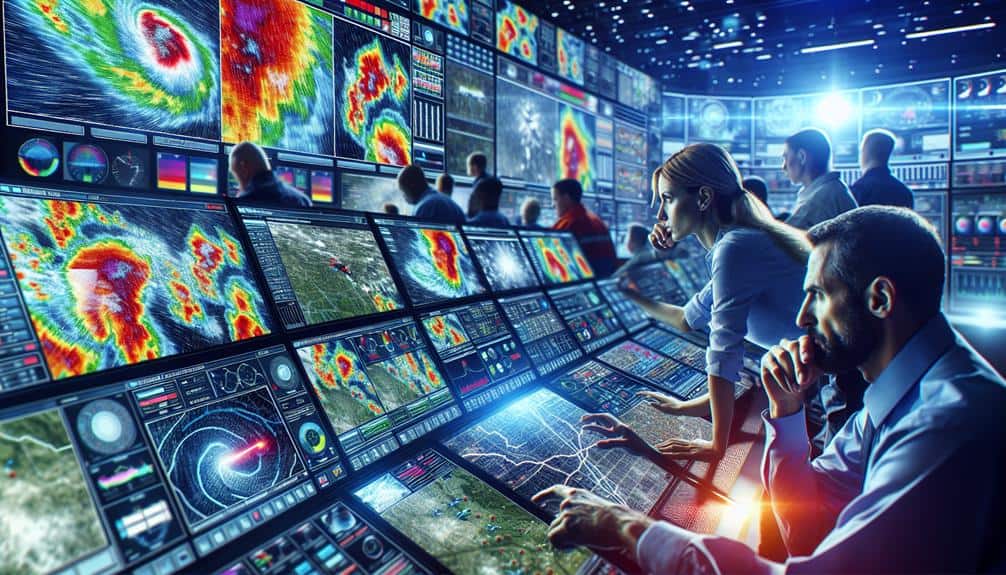We leverage historical and real-time hailstorm data to enhance emergency response strategies. By analyzing recurring patterns and using satellite imagery, we predict future occurrences and high-risk zones with precision. Our sensor networks and IoT devices provide granular, real-time data, which integrates into unified platforms for improved situational awareness. Quantitative metrics from impact assessments guide resource allocation and emergency asset pre-positioning. Additionally, our probabilistic forecasts and intuitive dashboards optimize multi-agency coordination. This data-driven approach empowers us to reduce response times, minimize damage, and enhance community preparedness. For those interested, there's more to explore on optimizing emergency response with advanced technologies.
Key Points
- Utilize real-time satellite and sensor data to monitor hailstorm development and issue timely alerts.
- Implement machine learning models to predict hailstorm trajectories and potential impact zones.
- Integrate meteorological data with GIS to enhance situational awareness and emergency response coordination.
- Conduct comprehensive damage assessments using drone surveillance and satellite imagery for informed resource allocation.
Understanding Hailstorm Patterns
To effectively respond to hailstorms, we must first analyze historical data to identify recurring patterns and anomalies. By scrutinizing hailstorm frequency over several decades, we can discern trends that inform our emergency response strategies. We rely on meteorological databases and satellite imagery to map out the incidences and intensities of hailstorms, providing us with a detailed view of their behavior.
Climate change impact is a critical factor we need to take into account. Shifts in global weather patterns, driven by rising temperatures, can alter the frequency and severity of hailstorms. By integrating climate models with historical data, we can better understand how these changes might influence future events. This data-driven approach allows us to anticipate areas at higher risk and allocate resources more efficiently.
Additionally, statistical analysis helps us pinpoint anomalies that deviate from expected patterns. These irregularities could signal emerging trends or shifts in hailstorm behavior, necessitating adjustments in our predictive models. By continually updating our datasets and refining our analytical methods, we can stay ahead of the curve, ensuring that our emergency response plans are both proactive and adaptive.
This empowers us to maintain a high degree of readiness and safeguard communities against the evolving threat of hailstorms.
Predicting Hailstorm Occurrences
To predict hailstorm occurrences accurately, we must leverage historical weather data analysis and integrate real-time data streams. By applying advanced machine learning models, we can identify patterns and forecast potential hailstorm events with higher precision.
This data-driven approach enhances our emergency response capabilities, reducing risks and improving outcomes.
Historical Weather Data Analysis
Analyzing historical weather data allows us to identify patterns and predict future hailstorm occurrences with greater accuracy. By conducting in-depth weather trend analysis, we can discern recurring climatic conditions that lead to hailstorm formation. This entails examining variables such as temperature gradients, atmospheric pressure, and humidity levels over extended periods. Such an approach transforms raw data into actionable insights, enabling us to anticipate when and where hailstorms are likely to strike.
Our geographic impact assessment focuses on regional vulnerabilities, pinpointing areas historically prone to severe hail. We map out these high-risk zones using historical data, ensuring that emergency response teams can allocate resources effectively. By correlating geographic patterns with meteorological data, we can refine our predictive models, enhancing their reliability.
Utilizing sophisticated algorithms, we analyze vast datasets to uncover hidden correlations. Machine learning techniques, for instance, allow us to sift through years of weather records, identifying subtle indicators of impending hailstorms. These advanced analytical tools empower us to craft more precise forecasts, mitigating risk and safeguarding communities.
Ultimately, harnessing historical weather data not only improves our predictive capabilities but also promotes a proactive approach to emergency preparedness, granting us the freedom to respond swiftly and effectively.
Real-time Data Integration
Integrating real-time data streams from satellite imagery, radar systems, and ground-based sensors allows us to predict hailstorm occurrences with unprecedented accuracy. By leveraging these diverse data sources, we can implement advanced data visualization techniques and predictive modeling to identify potential hailstorm developments in their early stages. This integration offers us the capability to dynamically track storm systems, analyze atmospheric conditions, and pinpoint regions at high risk for hail formation.
Our predictive modeling algorithms process this real-time data to generate probabilistic forecasts. These forecasts enable us to issue timely emergency alerts, ensuring that communities are well-prepared for imminent hailstorms. Effective communication strategies are essential in disseminating these alerts; we utilize multiple channels such as mobile notifications, social media platforms, and emergency broadcast systems to reach the widest audience possible.
Moreover, the ability to visualize real-time data on intuitive dashboards allows emergency responders and decision-makers to make informed, swift actions. By presenting complex data in an accessible format, we empower individuals and organizations to take proactive measures, reducing potential damages and enhancing overall safety.
This real-time data integration not only enhances our predictive capabilities but also fortifies our emergency response framework, granting us greater freedom to mitigate the impacts of severe weather events.
Machine Learning Models
Our machine learning models harness extensive datasets to predict hailstorm occurrences with remarkable accuracy, enhancing our ability to safeguard communities. We employ rigorous model accuracy evaluation to validate our predictions are both reliable and actionable.
By leveraging advanced feature selection techniques, we identify the most critical variables, such as atmospheric pressure, temperature, and humidity, which greatly influence hailstorm formation.
Hyperparameter tuning plays a pivotal role in refining our models. Through systematic adjustments and cross-validation, we optimize parameters to improve predictive performance and minimize errors. This iterative process helps us achieve a balance between bias and variance, ensuring strong generalization to unseen data.
Model interpretability is paramount for us. We prioritize transparency, enabling stakeholders to understand the rationale behind predictions. Techniques such as SHAP (SHapley Additive exPlanations) values and LIME (Local Interpretable Model-agnostic Explanations) provide insights into feature importance and model behavior, fostering trust and facilitating informed decision-making.
Real-Time Data Collection

To enable effective emergency response, we must harness real-time hailstorm data through advanced sensor networks and satellite technology. By integrating these tools, we can enhance our weather monitoring capabilities and improve data visualization. Real-time data collection allows us to capture precise information about hailstorm developments, making our emergency responses more timely and effective.
Let's explore the components essential for real-time data collection:
- Sensor Networks: Utilizing ground-based sensors, we can monitor hailstone size, frequency, and impact. These sensors provide immediate feedback critical for swift decision-making.
- Satellite Technology: Satellites offer a broad view, tracking storm movements and intensity from space. This data complements ground-based measurements, ensuring thorough coverage.
- IoT Devices: Internet of Things (IoT) devices placed in strategic locations enhance data granularity. They provide localized weather conditions, contributing to a detailed understanding of storm patterns.
Analyzing Hailstorm Impact
Analyzing hailstorm impact involves examining data on property damage, agricultural losses, and disruptions to infrastructure and services. First, we gather quantitative metrics from satellite imagery, drone surveillance, and ground reports to conduct an extensive damage assessment. By integrating these diverse data sources, we create a detailed map of affected areas, highlighting the severity and distribution of damage.
In our impact assessment, we focus on key indicators such as the cost of repairs, the extent of crop destruction, and the time required to restore essential services. By utilizing advanced statistical models, we can predict long-term economic repercussions and identify regions most in need of aid. This data-driven approach guarantees that our assessments are both accurate and actionable.
Additionally, we analyze historical data to identify patterns and trends in hailstorm occurrences and their impacts. This helps us understand the frequency and intensity of such events, providing valuable insights for future preparedness. By leveraging this analytical framework, we empower communities to make informed decisions, optimizing resource allocation and minimizing the adverse effects of hailstorms.
Our goal is to provide the necessary tools for effective impact assessment, enabling communities to respond swiftly and efficiently.
Enhancing Response Strategies

We can improve our response strategies by utilizing real-time data to predict hailstorm trajectories and impact zones. This enables us to allocate resources more efficiently, reducing response times and optimizing emergency efforts.
Real-time Data Utilization
By integrating real-time hailstorm data into our emergency response systems, we can greatly enhance situational awareness and decision-making accuracy. Leveraging advanced data visualization tools, we can turn raw data into actionable insights that empower us to act swiftly and effectively. This capability is vital in emergency management, where every second counts.
Incorporating real-time data enables us to:
- Monitor hailstorm progression: By tracking storm movements minute-by-minute, we can predict impact zones and issue timely warnings.
- Assess damage potential: Real-time data helps us estimate the severity of hailstorms and the potential for property and infrastructure damage.
- Optimize resource deployment: With precise data, we can allocate resources more efficiently, focusing on areas that need immediate attention.
Using real-time data, we can also create detailed data visualizations that make complex information more digestible. These visual tools are essential for decision-makers who need to understand the situation quickly and act accordingly. By giving us the freedom to make informed, rapid decisions, real-time hailstorm data transforms emergency management from a reactive to a proactive operation.
Resource Allocation Efficiency
Frequently, optimizing the allocation of resources hinges on our ability to accurately interpret real-time hailstorm data and predict high-impact zones. By leveraging advanced meteorological models and geospatial analytics, we can pinpoint areas most likely to suffer noteworthy damage. This precise targeting significantly boosts our allocation effectiveness and reduces response time, ensuring that critical supplies and personnel are deployed where they're needed most.
When we analyze historical hailstorm data alongside real-time updates, we gain actionable insights that inform our resource distribution strategies. Predictive algorithms help us foresee areas at risk, allowing us to pre-position emergency assets. This preemptive approach not only minimizes delays but also maximizes the efficiency of our response efforts.
Moreover, harnessing data from multiple sources—such as satellite imagery, ground sensors, and public reports—enables us to create dynamic, updated risk maps. These tools facilitate rapid decision-making and adaptive resource management, freeing us from the constraints of outdated, static allocation methods.
Coordinating Emergency Services
Effective coordination of emergency services hinges on the precise and timely analysis of hailstorm data to allocate resources efficiently. We must make sure that our emergency response teams can quickly access real-time data, enabling best communication coordination and service deployment.
By leveraging advanced analytics, we can predict hailstorm paths and potential impact zones, which aids in response time optimization.
To achieve seamless coordination, we should focus on:
- Real-time data integration: Combining meteorological data with geographical information systems (GIS) to identify affected areas instantly.
- Automated alert systems: Implementing systems that notify emergency services and the public simultaneously, making certain everyone is well-informed and prepared.
- Resource tracking: Utilizing GPS and IoT devices to monitor the location and status of emergency assets, making sure they're deployed where needed most.
Our analytical approach guarantees that data-driven decisions enhance our ability to respond effectively and swiftly. By prioritizing accurate data collection and dissemination, we empower our emergency services to act decisively. This not only minimizes damage but also upholds the freedom and safety of our communities during hailstorm events.
Improving Community Preparedness

Harnessing the power of hailstorm data not only enhances emergency response coordination but also plays an essential role in bolstering community preparedness. By integrating this data into our community engagement strategies, we can optimize disaster drills and education programs. This ensures that residents are well-informed and ready to act when a hailstorm strikes.
Analyzing historical hailstorm patterns allows us to predict high-risk periods and locations, improving public awareness campaigns. We can disseminate timely alerts and critical information via multiple channels, empowering individuals to make informed decisions. Data-driven insights also help in tailoring emergency kits to include essentials specific to hailstorm scenarios, such as protective gear for vehicles and homes.
Our approach to community engagement focuses on actionable steps. For instance, conducting regular disaster drills based on real-world data scenarios enhances preparedness and reduces response times. We must also foster a culture of preparedness through continuous education and outreach initiatives. By leveraging hailstorm data, we don't just react to emergencies; we proactively equip our communities with the knowledge and tools they need to remain resilient.
Frequently Asked Questions
How Can Individuals Report Hailstorm Damage to Authorities?
When we face catastrophic hailstorms, reporting damage is essential. Individuals can contact the emergency hotline for immediate response or use online reporting tools for detailed data submission, ensuring rapid, efficient, and data-driven emergency aid deployment.
What Are the Economic Impacts of Frequent Hailstorms on Local Businesses?
Frequent hailstorms cause significant business losses, disrupting operations and supply chains. We must develop robust recovery strategies, leveraging insurance and disaster funds, to mitigate economic impacts and guarantee rapid recovery, safeguarding local economies and preserving financial freedom.
How Does Climate Change Influence the Frequency of Hailstorms?
Climate change acts like a catalyst, increasing the frequency of hailstorms. As extreme weather patterns shift, the data shows a rising trend in hail events, impacting both our local economies and the freedom to operate without disruption.
What Insurance Policies Cover Hailstorm Damage in Residential Areas?
In residential areas, insurance coverage for hailstorm damage typically falls under homeowners insurance policies. The claim process involves documenting damage, filing a report, and working with adjusters to guarantee thorough coverage for repairs and replacements.
Can Hailstorm Data Help in Urban Planning and Infrastructure Development?
Yes, we can use hailstorm data to enhance urban resilience and drive infrastructure adaptation. By analyzing patterns and severity, we'll design more durable buildings and resilient urban layouts, mitigating hailstorm impacts and promoting freedom through safer environments.


